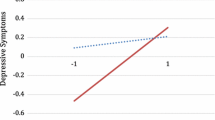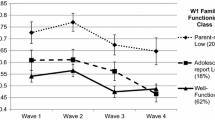Abstract
The present study examined the relationship between Berry’s acculturation typology and HIV risk behaviors and whether family functioning mediated any such effects. A total of 235 high risk Hispanic adolescents were categorized into one of Berry’s four acculturation typologies through the use of cut-off scores on measures of Hispanicism and Americanism. Structural equation modeling was used to examine the effects of acculturation typology on HIV risk behaviors and the indirect effects of acculturation typology on HIV risk behaviors through family functioning. Acculturation typology was related to HIV risk behaviors. Family functioning partially mediated the effects of acculturation typology on the HIV risk behavior outcomes. These findings suggest that both Americanism and Hispanicism play an important role in the etiology of HIV risk behaviors among Hispanic youth and that both, along with family functioning, are important to consider when designing preventive interventions for this population.

Similar content being viewed by others
Notes
Of the 242 enrolled, 7 are missing acculturation data and consequently are not included in the current study.
References
Centers for Disease Control and Prevention. Youth risk behaviors surveillance system. 2010. Retrieved 27 July 2010 from http://www.cdc.gov/HealthyYouth/yrbs/index.htm.
US Census Bureau. Summary File 2, Table PCT33, race or ethnic group: Hispanic, Mexican, 3 Dominican, Central American, Salvadoran, Guatemalan, Honduran. Washington, DC: US Census Bureau; 2000.
Marotta SA, Garcia JG. Latinos in the United States in 2000. Hispanic J Behav Sci. 2003;25(1):13–34.
Prado G, Shi H, Maldonado-Molina M, Bandiera F, Schwartz SJ, De la Vega P, et al. An empirical test of ecodevelopmental theory in predicting HIV risk behaviors among Hispanic youth. Health Educ Behav. 2010;37(1):97–114.
Szapocznik J, Lopez B, Prado G, Schwartz SJ, Pantin H. Outpatient drug abuse treatment for Hispanic adolescents. Drug Alcohol Depend. 2006;84(Supplement 1):S54–63.
Prado G, Schwartz SJ, Pattatucci-Aragón A, Clatts M, Pantin H, Fernández MI, et al. The prevention of HIV transmission in Hispanic adolescents. Drug Alcohol Depend. 2006;84(Supplement 1):S43–53.
Centers for Disease Control and Prevention. HIV surveillance report, 2008; vol 20. 2010. Retrieved 1 Dec 2010 from http://www.cdc.gov/hiv/topics/surveillance/resources/reports.
Driscoll AK, Biggs MA, Brindis CD, Yankah E. Adolescent Latino reproductive health: a review of the literature. Hispanic J Behav Sci. 2001;23(3):255–326.
Martin JA, Hamilton BE, Menacker F, Sutton PD, Mathews TJ. Preliminary births for 2004: infant and maternal health. 2005. Retrieved 1 Dec 2010 from http://www.cdc.gov/nchs/data/hestat/prelimbirths04/prelimbirths04health.htm.
Johnston L, O’Malley P, Bachman J, Schulenberg J. Monitoring the future national results on adolescent drug use: overview of key findings 2009 (NIH Publication No. 10-7583). Besthesda, MD: National Institute on Drug Abuse; 2010.
National Institute of Drug Abuse. Drugs, brains, and behavior: the science of addiction (NIH Publication No, 10-5605). Bethesda, MD: National Institute on Drug Abuse; 2008.
Teplin LA, Elkington KS, McClelland GM, Abram KM, Mericle AA, Washburn JJ. Major mental disorders, substance use disorders, comorbidity, and HIV-AIDS risk behaviors in juvenile detainees. Psychiatr Serv. 2005;56(7):823–8.
McClelland GM, Elkington KS, Teplin LA, Abram KM. Multiple substance use disorders in juvenile detainees. J Am Acad Child Adolesc Psychiatry. 2004;43(10):1215–24.
Amaro H, Whitaker R, Coffman G, Heeren T. Acculturation and marijuana and cocaine use: findings from HHANES 1982-84. Am J Public Health. 1990;80(12):54–60.
Saint-Jean G. Gender differences in the salience of psychosocial mediators of the impact of acculturation on substance abuse among Hispanic youth in Florida. J Immigr Minor Health. 2010;12(2):166–72.
Szapocznik J, Kurtines WM, Fernandez T. Bicultural involvement and adjustment in Hispanic-American youths. Int J Intercult Relat. 1980;4(3–4):353–65.
Berry JW. Conceptual approaches to acculturation. In: Chun KM, editor. Acculturation: advances in conceptual approaches to acculturation. Washington, DC: American Psychological Association; 2003.
Caetano R, Ramisetty-Mikler S, Rodriguez LA. The Hispanic Americans Baseline Alcohol Survey (HABLAS): the association between birthplace, acculturation and alcohol abuse and dependence across Hispanic national groups. Drug Alcohol Depend. 2009;99(1–3):215–21.
Hines AM, Caetano R. Alcohol and AIDS-related sexual behavior among Hispanics: acculturation and gender differences. AIDS Educ Prev. 1998;10(6):533.
Sullivan S, Schwartz SJ, Prado G, Shi H, Pantin H, Szapocznik J. A bidimensional model of acculturation for examining differences in family functioning and behavior problems in Hispanic immigrant adolescents. J Early Adolesc. 2007;27(4):405–30.
Falicov CJ. Latino families in therapy: a guide to multicultural practice. New York: Guilford Publications; 2000.
Galanter M. Alcohol problems in adolescents and young adults: epidemiology, neurobiology, prevention, and treatment. New York, NY: Springer; 2006.
Godley MD, Kahn JH, Dennis ML, Godley SH, Funk RR. The stability and impact of environmental factors on substance use and problems after adolescent outpatient treatment for cannabis abuse or dependence. Psychol Addict Behav. 2005;19(1):62–70.
Hogue A, Dauber S, Samuolis J, Liddle HA. Treatment techniques and outcomes in multidimensional family therapy for adolescent behavior problems. J Fam Psychol. 2006;20(4):535–43.
Lederman CS, Dakof GA, Larrea MA, Li H. Characteristics of adolescent females in juvenile detention. Int J Law Psychiatry. 2004;27(4):321–37.
Unger J, Ritt-Olson A, Wagner K, Soto D, Baezconde-Garbanati L. Parent–child acculturation patterns and substance use among Hispanic adolescents: a longitudinal analysis. J Primary Prevent. 2009;30(3):293–313.
Martinez CR. Effects of differential family acculturation on Latino adolescent substance use. Fam Relat. 2006;55(3):306–17.
Birman D. Biculturalism and perceived competence of latino immigrant adolescents. Am J Community Psychol. 1998;26(3):335–54.
Gorman-Smith D, Tolan PH, Zelli A, Huesmann LR. The relation of family functioning to violence among inner-city minority youths. J Fam Psychol. 1996;10(2):115–29.
Tolan PH, Gorman-Smith D, Huesmann LR, Zelli A. Assessment of family relationship characteristics: a measure to explain risk for antisocial behavior and depression among urban youth. Psychol Assess. 1997;9(3):212–23.
Jemmott JB, Jemmott LS, Fong GT. Abstinence and safer sex HIV risk-reduction interventions for African American adolescents. JAMA. 1998;279(19):1529–36.
Kline RB. Principles and practice of structural equation modeling. 3rd ed. New York: Guilford Publications; 2010.
Muthen LK, Muthen BO. Mplus: statistical analysis with latent variables: user’s guide. Los Angeles: Authors; 1998–2010.
Holmes KE. Early predictors of downward assimilation: a study of contemporary second-generation immigrants. Unpublished dissertation. 2008.
Gangamma R, Slesnick N, Toviessi P. Comparison of HIV Risks among gay, lesbian, bisexual and heterosexual homeless youth. J Youth Adolesc. 2008;37(4):456–64.
Szapocznik J, Kurtines WM. Family psychology and cultural diversity: opportunities for theory, research, and application. Am Psychol. 1993;48:400–7.
Prado G, Pantin H. Reducing substance use and HIV health disparities among Hispanic youth in the USA: the Familias Unidas program of research. Psychosoc Interv. 2011;20(63–73):2011.
Prado G, Pantin H, Briones E, Schwartz SJ, Feaster D, Huang S, et al. A randomized controlled trial of a parent-centered intervention in preventing substance use and HIV risk behaviors in Hispanic adolescents. J Consult Clin Psychol. 2007;75(6):914–26.
Pantin H, Schwartz SJ, Sullivan S, Coatsworth J, Szapocznik J. Preventing substance abuse in Hispanic Immigrant adolescents: An ecodevelopmental, parent-centered approach. Hispanic J Behav Sci. 2003;25(4):469–500.
Schwartz SJ, Zamboanga BL. Testing Berry’s model of acculturation: a confirmatory latent class approach. Cult Divers Ethnic Minor Psychol. 2008;14(4):275–85.
Pantin H, Prado G, Lopez B, Huang S, Tapia MI, Schwartz SJ, et al. A randomized controlled trial of Familias Unidas for Hispanic adolescents with behavior problems. Psychosom Med. 2009;71(9):987–95.
Acknowledgments
This study was supported by National Institute on Drug Abuse grant # R01 DA025894, #R01 DA025192 and Center for Disease Control and Prevention grant #U01PS0000671 awarded to Guillermo Prado and National Institute on Minority Health and Health Disparities Loan Repayment Program 1L60MD006269-01 to David Cordova. We would like to thank the members of the study team as well as the families who participated in this study.
Author information
Authors and Affiliations
Corresponding author
Rights and permissions
About this article
Cite this article
Farrelly, C., Cordova, D., Huang, S. et al. The Role of Acculturation and Family Functioning in Predicting HIV Risk Behaviors Among Hispanic Delinquent Youth. J Immigrant Minority Health 15, 476–483 (2013). https://doi.org/10.1007/s10903-012-9627-1
Published:
Issue Date:
DOI: https://doi.org/10.1007/s10903-012-9627-1




